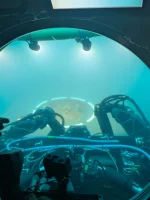
DRDL, a branch of the DRDO located in Hyderabad, has announced a significant advancement in hypersonic missile technology. In a groundbreaking achievement, DRDL successfully conducted a 120-second ground test of an active-cooled scramjet combustor, marking the first time such a feat has been accomplished in India. This success signifies a critical step towards the development of next-generation hypersonic missiles, weapons capable of travelling at speeds exceeding Mach 5 (five times the speed of sound).
Hypersonic missiles represent a new frontier in military technology, possessing the ability to overcome current air defence systems due to their incredible speed and maneuverability. Countries like the United States, Russia, and China are also actively engaged in the pursuit of this technology. At the heart of these advanced weapons lies the scramjet engine, an air-breathing propulsion system capable of maintaining combustion at supersonic speeds without the need for any moving parts.
The recent ground test conducted by DRDL demonstrated the scramjet combustor's potential for real-world application in hypersonic vehicles. Notably, the test successfully achieved ignition and sustained stable combustion, a challenge often compared to "keeping a candle lit in a hurricane" due to the extremely high air intake velocity. This was made possible by an innovative flame stabilization technique that allows for a continuous flame to be maintained within the combustor even at air speeds exceeding 1.5 kilometers per second. The final scramjet engine configuration was reached after extensive research, including numerous ground tests and advanced computational fluid dynamics (CFD) simulations to evaluate and predict performance.
A key factor in this breakthrough was the indigenous development of a specialized endothermic scramjet fuel, a first for India. This fuel, developed in collaboration with private industry, provides superior cooling capabilities and improved ignition characteristics. To meet DRDL's stringent requirements, a unique manufacturing process was created to produce this fuel on an industrial scale.
Further enhancing the scramjet's capabilities is a state-of-the-art thermal barrier coating (TBC) designed to withstand the extreme temperatures generated during hypersonic flight. This advanced ceramic TBC, developed jointly by DRDL and a Department of Science & Technology (DST) laboratory, possesses high thermal resistance and can operate beyond the melting point of steel. Specialized deposition methods were employed to apply the coating inside the scramjet engine, ensuring enhanced performance and longevity.
Defence Minister Rajnath Singh commended DRDO and its industry partners for this accomplishment, recognizing its importance in the development of future hypersonic missiles. Dr. Samir V Kamat, Secretary of the Department of Defence R&D and Chairman of DRDO, also congratulated the DRDL team and industry collaborators for their success in demonstrating stable combustion, enhanced performance, and advanced thermal management. This breakthrough positions India as a significant player in the field of hypersonic technology and paves the way for the development of cutting-edge defence capabilities.


